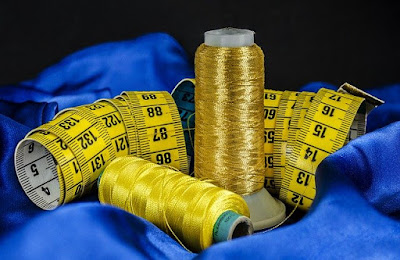Texturizing can be termed as the process in which loops,
crimps or coils are introduced into a continuous filament yarn. During the
process of yarn texturizing a partially oriented yarn is used as feed yarn.
Spinning speeds between 3000 m/min to 4000m/min provides a partially oriented
yarn which later requires draw of two during the draw texturizing.
What are the benefits of textured yarns?
One of the most important advantages of textured yarn is
that it gives good comfort as the result of the air entrapped between the
interstices of the yarn. It also provides better pill resistance, dimensional
resistance and improved crease resistance. They have fuller and better
appearance. Comes with easy to wash and dry characteristics with better shape
retention ability.
Textured yarns are qualified as:
- Stretch yarns: These types of yarn provide better extensibility and good recovery. They are produced by false twist texturizing or by edge crimping using only one heating zone. High stretch 300 to 400%with moderate to high bulk.
- Modified stretch yarns: They are produced by the presence of second heating zone during false twist or edge crimping process. They have moderate stretch (100-150%) with high bulk.
- Bulk yarns: They are produced by fear crimping, stuffer box, air jet and knit-de-knit processes. They have no stretch and high bulk.
Texturizing methods:
Texturizing methods includes false twist texturizing,
edge crimping, stuffer box, knit-de-knit and air jet texturizing. In this
article we will discuss false twisting, stuffer box, Halenca process and edge
crimping method of texturing.
False twist texturizing method:
In a false twist texturizing machine, the passage of the
multi- filament yarn is as: Feed roller- heating- cooling- twister- take up
roller. Modified stretch yarn is
obtained with 300% stretch. In this process a POY yarn is allowed to pass
between two shafts. The POY yarn is then fed to the shaft one from which it is
passed on the shaft two. When the yarn is fed to the machine it has to be drawn
and twisted. Once the yarn is out of shaft one, it reaches a heater which heats
the yarn at low temperature where it can be thermoset. Soon after that reaches s cooling system which
cools the yarn at the low temperature so as to thermoset the twist. The
twisting is carried out by friction device like a set of rotating discs there
are different types like belts. To obtain a modified stretch yarn there is a
need to follow some conditions. Firstly, pass it through a secondary heater
with an overfeed and secondly, the temperature should be less than primary
heater.
Stuffer box method:
In this process the filaments are stuffed in a confined
space of a heater chamber which is called as a stuffer box. In the stuffer box,
the filaments are heat set in their crimped from and then they are withdrawn.
These yarns are soft, bulky and offer good absorption properties and have less
extensibility. The amplitude and frequency of the crimp can be controlled but
all the crimps will not be in the same size. The range of the stretch is in the
same as that of the modified stretch yarn i.e., 100-150%
Halenca process of producing modified stretch textured
yarns:
In this process of producing modified stretch yarn the
aim is to reduce the stretch 100-150%. It is a batch process, follows the
pattern of twist-heatset-detwist-make a soft package-reset. Firstly, a multi
filament twisted package is taken and heat setted, where the twist is set then
it is cooled and then the twist was eliminated this is called as detwisting.
After detwisting the textured yarn obtained is converted into soft package.
Basically, a soft package is a package where in a low tension is applied,
Tension to an extent where is done not open out the textured yarn completely but
their will be some amount of helical structure on the filament.
The soft packages then reset where it will be heated but
with temperature less than that of previous heater this can be called as
secondary heater. In a soft package the yarn has got some scope to relax the
secondary heater temperature must be lower than the primary heater temperature.
We make soft package so that the textured yarn is not fully stretched before
secondary heating, if we stretched fully all the texture we have given in the
first step shall disappear.
Edge crimping texturing method:
This method gives a stretch yarn. In this process a blunt
knife edge is taken and the filament is drawn over the knife blunt edge. The
knife edge could be heated or the filament could be heated. When we draw the
filament over the knife edge the part of filament which is near the knife has
to travel less distance than the filament in the outer edges. This result in
stretching of outer filament in more amounts compared to that of filament near
the edge. This is caused due to phenomenon of bilateral compression and
extension strain which develop crimps. The yarn obtained is helical in
structure without twisting.
What type of yarns can be textured?
Synthetic filaments yarns made from polyester, nylon and
polypropylene. Nylon yarns in the range of 15-110 deniers, with the majority of
fine hosiery yarns being 20 denier and coarser yarn being 70 denier. Polyester
yarns are normally in the range between 50-300 denier, with the emphasis on 75
and 150 denier.






2 Comments
In stuffer box method, why the crimps will not be in the same size?
ReplyDeleteIt's not fear crimping (bulk yarns), its gear crimping method, my wise little friend.
ReplyDelete